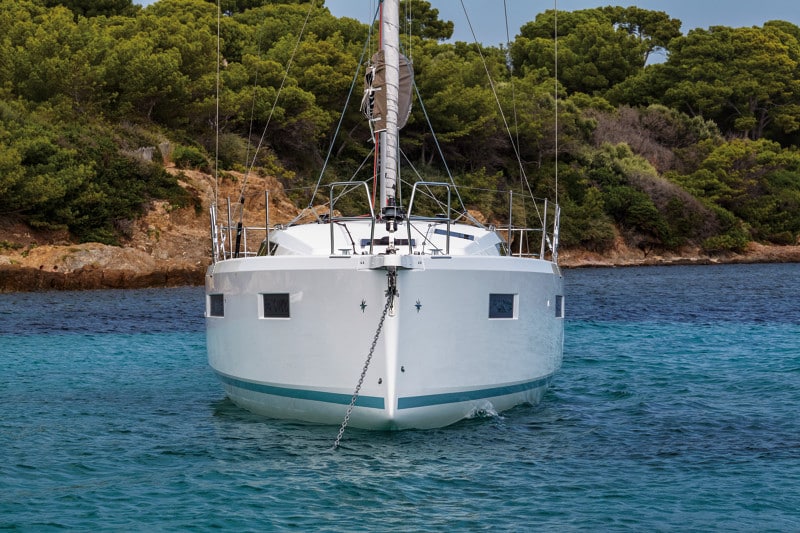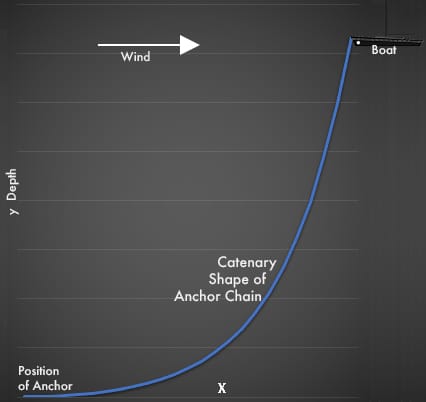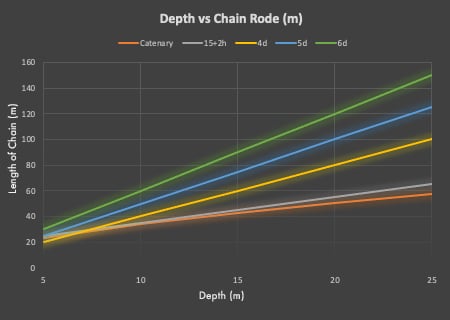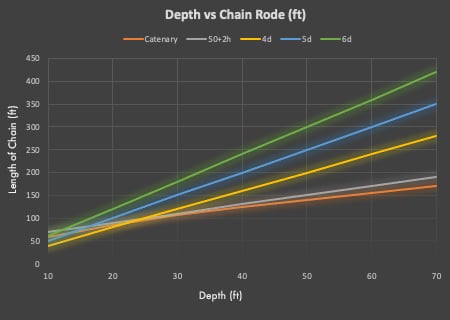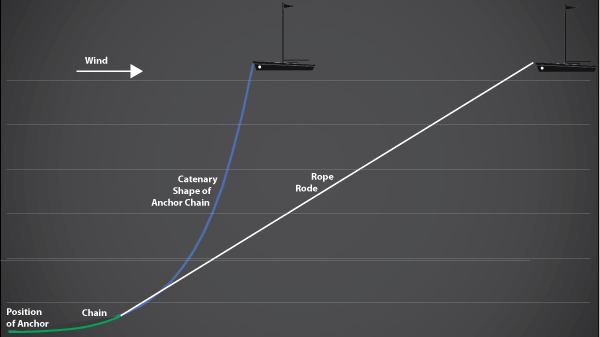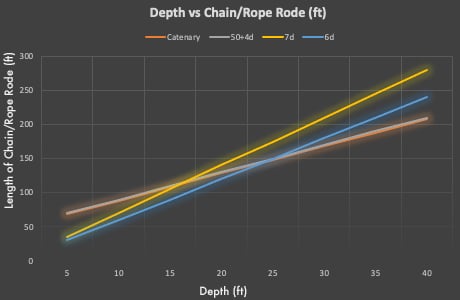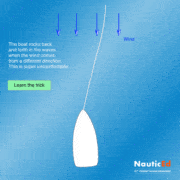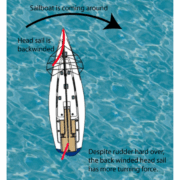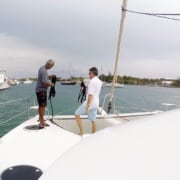
This article is an excerpt from NauticEd’s online Skipper Large Keelboats Course, a comprehensive online sailing course for beginner to intermediate sailors to learn how to sail large sailboats 26 ft (8m) and above. The Skipper Large Keelboats course is part of the Skipper Course Bundle of online courses, also teaching you how to master maneuvering under power and docking!
You can learn to sail and improve your sailing with NauticEd, the international leader in sailing education.
The following is an excerpt from the NauticEd Skipper Large Keelboat Course, the NauticEd Skipper Small Keelboat Course, and the NauticEd Anchoring Course.
Anchoring, and getting it right is such an important topic that we thought we’d make this excerpt available for free in open space.
Please enjoy how we dive into science and mathematics in these courses. If you like our style and how much knowledge you believe you could pick up in a full NauticEd course based on this little excerpt, consider take our full range of online sailing courses. Plus NauticEd has practical on-the-water training schools throughout the USA and Canada as well as other international locations. Check out, our two free sailing courses.
NauticEd is a recognized sailing education body by the United States Coast Guard and can issue an official sailing license which is required by some countries to sail in their waters.
How Much Anchor Rode to Let Out
You cannot simply dangle your anchor on the bottom and expect it to hold or for that matter, let out a little more and expect it to hold. An anchor needs to be firmly dug into the bottom with the correct amount of anchor rode let out. And when the tension comes on to the anchor from the pull of the wind and waves on the boat on the surface above, the rode must act to continue to pull the anchor horizontally across the bottom rather than in any vertical direction. An upwards pull at any angle will tend to lift the anchor out of the bottom and allow your boat to drift.
There is a saying that goes like this
I’d rather be on a boat with a drink on the rocks
than in the drink with a boat on the rocks
Having your boat on the rocks because your anchor drifted in the night is very VERY bad. For this reason, there is a science to figuring out how much anchor rode to let out. The science is based on mathematics and on empirical data from many tests by anchor manufacturers and real sailor usage over a very long period of time.
Most sailors have heard the stories about the VERY bad ramifications of dragging anchor and they continue to be nervous about any anchoring operation. Without any understanding of anchoring, those sailors should continue to be nervous. For this reason, the science and mathematics of how much anchor rode you should let out is explained in great detail below. After understanding this, your nervousness should go away and your confidence and competence go up.
All Chain Rode
The weight of chain near the anchor end of the rode holds the shank (the long arm) of the anchor down on the bottom and ensures the anchor is pulled in a horizontal direction along the bottom. But this is only true if there is enough weight in the chain to overcome the wind and wave pulling forces above.
This animation shows you how the anchor holds fast into the bottom by having the chain laying on the bottom even during a gust of wind.
It is thus important to have sufficient chain let out to maintain this horizontal pull. Sufficient chain means even when the strongest wind comes through, some chain remains laying on the bottom.
The Catenary
The word catenary is derived from the Latin word “catenaria” which translates to chain. Thus, when a chain is held at two ends, it will follow the shape called a catenary. Several mathematicians in the 17th century derived the formula to plot the shape of a catenary.
Here below is the mathematical expression for the catenary shape of the chain falling from a boat to a fixed anchor at the bottom where the initial slope of the chain on the bottom is completely horizontal. Don’t worry too much about the complexity of the formula, just understand that it is a hyperbolic function rather than linear – meaning that it is way stepper at the top near the boat because of the weight of the chain. And that we want to apply the formula because we want the chain to be completely horizontal at the anchor point – this ensures that the horizontal force from the wind on the boat at the water surface is transferred to a horizontal force on the anchor at the bottom. This makes the anchor continue to dig in rather than lift up. The argument suggests then that we want to follow the catenary formula rather than guess.
This can be simplified if we just want to know what is going on at the endpoints to:
Where:
- H is the horizontal force on the boat from the wind and waves
- h is the depth of the water
- w is the weight of chain per unit length
- CL is the Chain length
You can see from the formula that as you increase the wind speed force value (H), the chain length must increase to maintain the catenary shape. You can also see that if you use heavier chain, the chain length can decrease. And obviously, as you increase the depth, the chain length goes up. The formula thus makes sense to reality at least in terms of how the variables are applied.
So for any given depth, chain weight, and force on the boat you can instantly in your head use the above formula to calculate the amount of chain to let out – right? Haa haa!
Instead, people have come up with simple formulas to ensure you have enough chain out to keep the catenary shape. Most people use a simple multiplier like x times the depth. And for chain 4 times the depth seems to work decent enough for average depths. But it does not work for shallow depths. Using 6 times the depth or more becomes too impractical for deeper depths because you won’t have that amount of chain on your boat.
A good approximation to the above complicated formula which will work for most mid-size to large sailboats (30 to 50 ft, 10 to 15 m) in high winds to 30 knots is:
- For meters: Chain length =15m + 2 times the depth
- For feet: Chain length = 50ft + 2 times the depth
It means that in any anchoring situation, let out at least 15 meters (50 ft) and then further determine the amount by multiplying the depth of water by 2. Shown in the graphs below is how the various formulas plot out on a graph so that you can see how they track the catenary for a 40 ft boat in a 30-knot wind. To read the graph so as to compare the formulas, choose a depth say 10m or 30 ft (about the same), the catenary formula and the 15+2d (m) (or 50+2d (ft)) as well as the 4x formulas all say to let out about 37 – 40 m (120-130ft) of chain. If we get to some depth like 20 meters or 60 feet, the 4x, 5x, and 6x formulas say to let out 80m (250ft), 100m (300ft), and 120m (350ft) of chain respectively which is impractical due to the amount of stored chain on the boat. Also, the more you let out the more your boat will swing in the anchoring area possibly taking you near rocks and other boats. At a shallow depth on the left side of the graph, the 4x formula is too short to maintain the catenary.
Thus from the graph, you can see that for depth measured in meters, 15 plus 2 times the depth (15+2d) and for depths measure in feet 50 + 2 times the depth (50+2d) tracks well with the catenary.
However, there is an old saying that says you can never let out too much chain. We mostly agree. Just think of the limitations of your swing area and realize that the 15 + 2d (m) (or 50 + 2d (ft)) should be an absolute minimum. In big wind and/or wave conditions consider using more if practical. If you are stopping for a short lunch with little to no wind predicted, you could consider using less. If you plan on leaving the boat unattended for any amount of time ensure there is plenty of chain let out.
Ideally, when letting out, as the anchor touches the bottom, your boat begins to move slowly backward so as to lay the chain straight across the bottom. Once you have let out the desired amount of chain, apply about 1/2 throttle to set the anchor into the bottom and ensure it holds. Half throttle is plenty because you know that with 1/2 throttle force, your boat could still move forward against a big wind through waves. Thus 1/2 throttle against the anchor is more force against the anchor than the wind could typically produce.
The formula given above, while satisfying the mathematical theory, also agrees with empirical data from real sailors. But we want to make it clear that the formula means the chain catenary shape touches the bottom and the anchor at the same place. It is much better to have extra chain on the bottom in case the waves and wind pick up to gale force.
View this video by Richard MacFarlane, a well-known sailor and trainer, as he explains how his boat held in a storm using the 15+2d formula when others didn’t and the carnage that followed.
Common examples of the minimum amount of chain using the 50 + 2d or 15 + 2d methods are:
- 10 ft depth let out 70 ft (see how 4 times the depth (or even 5 ) would not be enough)
- 20 ft depth let out 90 ft
- 30 ft depth let out 110 ft
- 40 ft depth let out 130 ft
- 50 ft depth let out 150 ft
or for meters
- 5 m depth let out 25 m
- 10 m depth let out 35 m
- 15 m depth let out 45 m
- 20 m depth let out 55 m
If you’re an old hat at sailing, you’ll agree that these numbers are realistic and perhaps you let out more at times.
So how do you now measure the amount of chain that has been let out?
Some modern boats have a digital chain counter – that is a really nice feature. But many boats don’t. We highly advise adding markers onto the chain to indicate various lengths of say every 10 meters. This can be done with plastic inserts or many people just use different colors of marine-grade paint or even stripes of paint – one representing every 10 meters (1 stripe at 10 m, 2 stripes at 20 meters etc).
If you know you dropped the anchor to the bottom next to another boat then you can use your boat length as the measuring gauge. Say the depth was 30 ft and you wanted to let out 110 ft of chain (50 + 2 x 30) and your boat is 30 ft long then 3 boat lengths when you apply a 1/2 reverse throttle will about meet your formula. To gain experience and confidence with this concept, consider snorkeling the anchor after you have laid it. Observe how much chain lays on the bottom when a gust comes through.
Chain Plus Rope Rode
If your rode is made up of chain and rope, you can not use the full catenary effect of the chain running all the way back up to the boat. However, there is a small chain catenary near the bottom from the short amount of chain attached to the anchor. The theory then is to not disturb the chain section catenary shape when continuing to run the rope road up to the boat. This is done by understanding the angle of the catenary at the transition from chain to rope. If this angle is maintained then the chain catenary is undisturbed.
From the image below, you can see both cases of a full chain catenary and the part chain part rope shape. It shows that the boat using rope rode must let out more anchor rode. The rope rode is assumed to pull in a straight line from the chain transition to the boat and thus not disturbing the chain catenary shape of the chain near the anchor.
By viewing this graph, you can understand why lengthening the chain section gives more holding power and allows for less rope rode. The traditional formula for calculating the amount of anchor rode with a rope/chain combination is 7 times the depth, but this almost never works in deeper water due to practicality. For example, a boat in 40 feet (12m) would need to let 280 ft (85m)of rode. Plus, a small boat in 7 ft (2m) of water would only let out 50 ft (15m) of rode which is not really enough.
A better formula based on the above chain formula and catenary model is:
- For meters use 15m + 4 times the depth
- For feet use 50ft + 4 times the depth
This formula closely models the theory consideration of not disturbing the catenary angle at the chain/rope transition. Any rope rode angle that is steeper will lift the chain and cause the pull angle on the anchor higher than horizontal which acts to prevent the anchor from digging in. The variables for this assumes a 30 ft (9m) boat and 30 knots of wind with an appropriately sized chain weight/unit length about 30 ft long (9m). Using these, a boat in 40 feet (12 m) of water would let out 210 feet (64m). Note that most smaller boats only have about 200 ft (60 m) of rode anyway. So 40 ft or 12 m is about the safe limit for anchoring depth if there is any decent amount of wind when using both chain and rope rode. Or if you typically want to anchor in deeper water in your smaller boat, just make your initial chain section longer.
Here is the plot of depth vs length of rope rode for the various models. It shows that the 50 + 4d (ft) (15 + 4d (m)) model closely overlays the catenary model. It also shows that the 7d and 6d lengths are not enough at shallower depths.
As stated above, there is an old saying that says you can never let out too much anchor rode. We mostly agree. Just again think of the limitations of your swing area and realize that the 15 + 4d (m) (or 50 + 4d (ft)) should be an absolute minimum. For a bigger boat in bigger winds and with big waves, you should use more. If you are stopping for a short lunch with little to no wind predicted, you could consider using less. If you plan of leaving the boat unattended for any amount of time ensure there is plenty of anchor rode let out.
Considerations
No matter just chain or chain and rode, you will always have some balancing decisions to make around how much rode to let out. Some factors to consider in your decision include:
- The harbor is crowded
- Some boats may be using all chain (and thus less swing)
- Your own swing circle
- Predicted night wind shifts and strengths
- Tidal change
- The amount of chain before rope on your rode
- The closeness to shore or underwater rocks inside my swing
- The type of bottom
Because of all these factors, it is best if you can that you snorkel over your anchor and check it is properly set and dug in before you turn in for the night or leave the boat. You should also set a GPS anchor alarm and a depth-change alarm to warn you if you have moved and multiple time alarms just to get up multiple times in the night to check.
NauticEd has incorporated a great anchor alarm into its own iOS TrackLink App and another app for Android and iOS called Anchor Zone. See these apps here. TrackLink is free to any NauticEd student who has purchased any course from us. TrackLink will also add your GPS track automatically to your logbook.
Scope
Scope is a term referred to the ratio of depth to the amount of rode you let out. It’s the formula discussed above where people use 4 times the depth (scope = 4) or 7 times the depth (scope = 7) etc. But for this discussion, we think it is OK that you also use the above formulas, 15 + 2d and 15 + 4d for meters and 50 + 2d and 50 + 4d for feet as a generic term of scope. The question goes like this – do you have plenty of scope? Or, what’s your scope? You can answer 15+2d! It will cause some confusion among those stuck on 7d but at least you know your rode length selection is based in science.
The Science
At the beginning of this page, we alluded to science being a factor in successful anchoring. And now, since you been run through the proverbial catenary ringer, you can certainly understand how anchoring using a proper “scope” attached to a hyperbolic function makes all the difference. You understand that you can design an anchoring situation using science and mathematics instead of listening to someone’s generic 4 times x ratio and hoping that the chain on the bottom is doing its job.
We have found that many people find anchoring very intimidating because they are nervous around the unknown – what is the anchor really doing on the bottom? There are not many courses out there that have derived the numbers from real formulas to give you a full understanding of how successful anchoring works. We believe that taking you through this exercise of excessive number crunching, graphs, and decently complicated theory will give you the confidence and ease of mind when “dropping the hook” and it is based properly on mathematics as well as matching empirically tested data.
Finally
Here’s a fun video where we dive the anchor and check its set and a few other things we found on the bottom. In the video, we promote that if you can observe plenty of chain remaining lying on the bottom when a gust comes through, that is also a good thing.
Notes
- If you plan on staying awake and aware, and anchoring for a short time, and the wind is light, you might be able to lessen your scope.
- Be aware that depending on the water depth a large amount of anchor rode set out can create a large diameter circle for your boat to swing around, which is sometimes not desirable.
- In general, try to anchor shallower keeping in mind tide, swing, and obstacles.
- In general, the more rode you let out, the better holding power of the anchor.
Anchor Billet
Many people successfully increase their holding power using an anchor billet. We discuss this in detail in the NauticEd online Anchoring a Sailboat course.
You can learn more in the Skipper Course....
Knowledge and theory for longer distances and overnight sailing in diverse conditions. The Skipper Course is a comprehensive online sailing course for beginner to intermediate sailors wanting to learn how to sail larger sailboats 26ft to 56ft. Or upgrade to the Skipper Course Bundle of online courses to also master maneuvering under power and docking!

